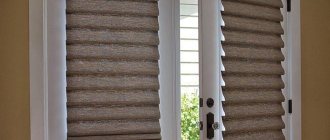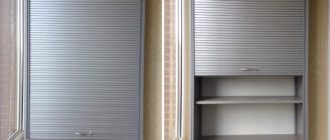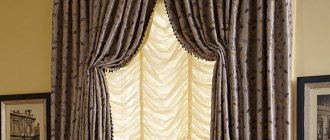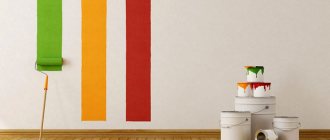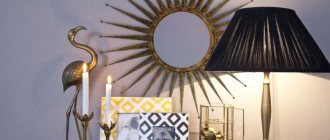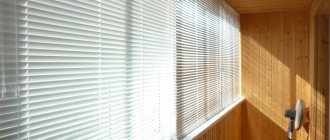SHARE ON SOCIAL NETWORKS
FacebookTwitterOkGoogle+PinterestVk
Paper blinds have recently become very popular among housewives who want to create unique comfort. This window decoration option is universal and multifunctional. But not everyone knows about the method of making blinds from ordinary wallpaper. This solution looks economical and original. To create such a product you need to have a minimum of knowledge and skills. In this publication you will learn how to create blinds from wallpaper with your own hands.
Making blinds from wallpaper at home is not difficult, and the result will exceed all expectations
DIY wallpaper blinds: inexpensive and beautiful
The heat of summer days forces even the most heat-resistant people to hide from the merciless rays of the sun. This is especially true for residents of high-rise apartments with windows facing south. But financial resources do not always allow you to buy high-quality blinds. Sometimes there is no time or desire to wait until they are made in accordance with the required parameters
Thanks to handmade paper blinds, you can shade a room and create an obstacle to the scorching rays of the sun
That is why the question of how to make blinds with your own hands is becoming more relevant than ever. For production you will need materials that everyone has at home. In addition, at this time, using wallpaper blinds with your own hands (photos of the use of such products can be found in the interior) is a common occurrence. This is not only an original, but also an affordable element of room decor. It also provides reliable protection for the room from overheating and curtains from fading.
Paper blinds fit harmoniously into the design of any room. But given the characteristics of the material, it is better not to use curtains in the kitchen and other utility rooms. Blinds made from wallpaper look organic on the windows of a dacha, veranda, loggia and balcony.
This product has many advantages:
- you can easily create it at home with your own hands;
- reliably protects the room from sunlight;
- decorates the window in an unusual way;
Considering the low cost of material for blinds, you can save a lot
- it is possible to use any pattern or design;
- does not interfere with flowers on the windowsill;
- suitable for any interior style;
- can be changed every week.
Paper blinds will prevent unnecessary waste, and will also save owners from the repeated need to go to the workshop. You only need to spend an hour or two on a homemade curtain, no more.
Designers recommend using both a plain material and a patterned material for the base, which will give a unique look to the interior. But wallpaper blinds also have some disadvantages:
- short service life;
You can use any type of wallpaper: paper, non-woven based
- rapid wear;
- They look cheap compared to salon models.
Where and how to attach?
There are many types of fastening:
- On a window sash that rotates. This can be done with glue, double-sided tape, and if wooden frames are used, then with push pins.
- On the window frame - so that the blinds cover the entire window.
- On the wall near the window, on top of the entire opening.
- For a frame for curtains - for those cases when a heavy structure with a sliding mechanism is made of paper.
Other types of fastening are possible. Here everything depends on the imagination of the manufacturer.
DIY window blinds: types of designs
The West Indian Indians invented blinds. Their models were distinguished by the presence of shutters with inclined wooden slats, which reliably protected from the sun. Such blinds were called colonial.
Venetian blinds appeared in the 18th century. The design of this model was characterized by the fact that the inner sides were fastened with hinges, and the outer sides with a cord. This made it possible to change the inclination of the lamellas in accordance with the time of year and weather.
The most common type of blinds that you can make yourself is pleated
Modern types of products are classified depending on the material from which the curtains are made and the method of their adjustment. Let's look at the most popular designs:
- Vertical models are blinds in which the parts are placed vertically and can be rotated at the required angle. You can adjust the rotation of the slats using a cord.
- Horizontal products - curtains designed in a “ladder” system. The slats are placed horizontally and are adjusted using a special drum.
- Roller blinds are blinds in the form of a sheet of fabric or paper that are rolled into a roll using a special mechanism. Such products are an ideal choice for the living room.
- Pleated blinds - the curtain material is folded in the form of an accordion. Adjustment is carried out with special cords and tapes, at the ends of which there are special clamps.
When choosing blinds, you need to pay attention to the shape of the window for which the curtain is intended, as well as the material and ease of adjustment.
Paper wallpaper holds the fold well, and therefore blinds made from it will look very impressive
Helpful advice! People who want to independently control the level of light in the room are better off choosing horizontal models or pleated blinds.
Curtain installation options
One of the important points is the installation of curtains. There are several methods for attaching curtains to a window:
- inside the opening. On the top of the window frame, opening, or on the wall above the window itself. To do this, mark the horizon, use fastening materials that are convenient for you;
- outside the opening. Suitable for non-standard windows located shallow in the wall. It will help to darken the room better. Installation may involve special brackets or mounting to the ceiling;
- to the window frame. This method of fastening is especially suitable for plastic windows. Curtains can be attached to the sashes using special fasteners. Opening and closing windows will be much more convenient.
What you need to make your own blinds
The question of how to make blinds yourself interests many women. Even people who have never done needlework can make curtains from wallpaper. But before starting work, you definitely need to select the material for the product, tools and decorations for decorating the finished curtain. And the process of creating blinds will take no more than 2 hours. Production time depends on the selected model.
To make blinds from wallpaper with your own hands, you will need the following tools:
- sharp scissors;
- hole punch, awl or similar tool;
- ruler;
Before you get started, you need to collect the necessary tools
- tape measure;
- pencil for marks.
Such devices are available in any home, so you don’t have to buy them specially. The material you need to find is:
- The basis of the curtains is wallpaper. You can use leftovers saved after renovation.
- To fix the position of the blinds, tape or decorative cord is used.
- Glue for joining parts.
- Regular and double-sided tape.
- A retainer (an ordinary bead, a clothespin matching the color of the wallpaper, or a hair clip will also work).
Instead of a regular rope, you can stretch a rope through all the blinds
Helpful advice! The quality of the curtain depends on the properties of the base. The better the material, the better the blinds will be. It is recommended to choose thick wallpaper, thanks to this the product will not tear for a long time.
If you choose a restrained color of the canvas, the curtain will fade slowly, which means it will retain its aesthetic appearance for a long period of time. It is also best not to use material with a pattern that is too large, as this may affect visibility in the room.
Preparing for work
To make your own curtains from wallpaper, you will need:
- roll of wallpaper;
- ribbons, ropes, laces;
- scissors, stationery knife;
- ruler, measuring tape;
- awl, clamp;
- glue, tape (including double-sided).
Once you have all the necessary tools and materials, you can begin making your blinds.
How to make blinds from wallpaper with your own hands: step-by-step instructions
Blinds made from wallpaper are often used on windows in country houses, loggias, balconies, verandas, as well as in rooms with windows facing the sunny side. They look original, and production costs are minimal.
The length of the wallpaper to be cut, taking into account the folds on the manufactured blinds, should be 25% greater than the height of the window
Such products are ideal for windows of non-standard sizes, because it is often problematic to buy curtains for these windows. In addition, these models, due to the density of the material, are able to completely protect the room from sunlight.
Before starting work, be sure to remove all unnecessary items and prepare the workplace. After all, to make high-quality and beautiful curtains you will need a lot of free space. It is important to prepare all the necessary materials and tools.
Step-by-step instructions will help you easily make blinds from wallpaper with your own hands:
- using a tape measure, measurements are taken of the window glass for which homemade blinds are made;
- since the fabric of the product bends horizontally, you need to add one-fourth of its length or 30-40 cm to its length. In this case, the size of the blinds will be correct. There is no need to change the width. For example, if the height of the window frame is 135 cm, you need to add another 25%, which in this case is 35 cm. As a result, a length of 170 cm is required;
The width of each strip varies between 3-5 cm
- the length of the decorative cord or ribbon must be greater than the size of the product; tying bows or knots must be taken into account. This value is also influenced by the method of fixing the lower part of the blinds;
Related article:
Roller blinds for plastic windows. Photos and installation options
Types of roller blinds. Advantages. Window installation options. Features of installing roller blinds with your own hands.
- Next, lay out the wallpaper and cut out the required rectangle from the material. It is important to ensure that the design on the canvas is not distorted or cut off. To prevent the roll from curling on the table, its edges can be pressed with a small weight. If the window is wider than the wallpaper, then you can use glue or tape to connect the two panels;
It is important that all folds are the same size, except for the very first one on which the curtain will be hung
- mark the corrugation and bend the fabric. The stripes should be even and parallel to each other. It is better not to make the fold width more than 7 cm. The optimal size is from 3 to 5 cm. To ensure that the bends are even and clear, it is recommended to use a ruler;
- I need to try on an unfinished curtain for the window. If necessary, the excess should be cut off;
- Depending on the curtain model, the middle of the folded material is marked with a pencil, or marks are left 15 cm from the edges for piercing holes. In the first option, one cord will be passed through the center of the blinds, in the second - two on the sides;
- Use a hole punch to make holes along the marked strip. An awl, screwdriver or any other similar tool is also suitable for this. The resulting hole must be slightly widened so that a rope or tape can be passed through it freely;
- To strengthen the paper, use tape. To do this, it is necessary to paste over the holes on both sides, after which they are re-done with a hole punch;
- then a strong ribbon or cord is pulled through the holes, then the accordion is straightened along the canvas. The upper end of the tape is fixed with a knot;
“Accordion” folded along marked lines
- Attaching the blinds to the window is done using double-sided tape. To do this, at the end of the curtain, on the fold, glue a strip of adhesive tape so that it completely covers the fold of the fabric. After this, the protective coating is removed and the product is attached to the window;
- At the bottom, the blinds are shaped like a fan. To do this, the last few strips are connected to each other with PVA glue or glued with tape. A cord or tape is secured from the window. Another option for decorating the lower part of the curtain is to leave it rectangular, tying it with ribbons at the bottom;
- To ensure that the blinds do not move apart along the entire length of the rope, a lock must be put on the lower edge. You can use a regular bead as it;
- the product is ready.
We thread a guide rope into the prepared holes
This is one of the options for making window blinds from wallpaper, but there are a lot of such instructions. The order of the design creation points will be similar, but there may be some differences that depend on the type of blinds.
There is an even simpler option for making pleated blinds, in which you don’t even need to thread the tape. In this case, the required length of wallpaper is folded like an accordion, as in the previous version. The finished curtain is attached to the frame with double-sided tape, and the lower part is fixed with a clothespin or hairpin, forming a beautiful peacock tail.
Helpful advice! The holes through which the cord is threaded must be covered with tape, otherwise the product will quickly collapse.
We stretch the rope along the entire length of the blinds
Making curtains and blinds with your own hands from paper is very easy, quick, and most importantly - cheap. You can use unnecessary pieces of wallpaper that remained after repairs, and ordinary utility tools. It is recommended to decorate the finished product with rhinestones, sparkles or patterns. If desired, the blinds on the side facing the street can be covered with foil. This will help reflect ultraviolet rays, preventing them from heating up the room.
In the case of arched windows, paper blinds will help you decorate them stylishly with elegant wallpaper fans. This method will not only protect you from the sun, but will also bring a special charm to the interior and emphasize the unusual shape of the window.
We fasten the rope stretched through all the blinds using double-sided tape to the fold, which is planned as the top
If there is a need to close only the upper part of the window so that the sun's rays do not fall on a certain area of the room, for example, a desktop or a baby's cradle, then a fan-shaped curtain is best suited. You can attach it to one of the corners of the frame. This option looks original and stylish both inside and outside.
You can also watch a video on how to make blinds from wallpaper with your own hands.
Accessories for roller blinds
Correctly selected fittings will make the curtain easy to use and create an attractive appearance. As accessories you can choose:
- Cornice. Will act as interior decoration. Such accessories are expensive, suitable for a living room or bedroom. If you have small windows and want to visually expand the space, then choose curtain rods 30-40 cm wider than the window. You can also hang the curtain rod just above the window opening.
- Runners, hooks. Economical, simple option for the kitchen. You will not have any problems with choosing sliders - they are all the same in terms of the method of fastening. All you have to do is decide on the appearance.
- Brackets, chains. The chain mechanism is very easy to use and is popular. Brackets are a durable structure onto which the shaft is mounted. If the blinds are made of thick wallpaper, then it is better to choose long brackets.
- Ropes. The rope mechanism is inexpensive and easy to implement: to do this, sew rings to the side panels and pass threads through them. Attach them to the bottom of the curtain.
- Weights. Serves as a weighting agent. Such a decorative accessory will allow you to emphasize the entire roll structure. All models have different colors, shapes, sizes, and styles, so you can choose the appropriate option for your blinds.
- Additional accessories: handles, decorative strips, other parts.
Types of mechanisms
There are two types of fastening roller blinds: open and closed:
- When the type is open, the cassette shaft on which the web is wound is visible. The shaft is mounted between two holders. This type of mechanism will allow you to fix the curtains above the window opening and in the opening itself. Wallpaper curtains can be controlled using a spring mechanism or a chain. Double-sided tape can serve as a fixation. The disadvantage of this design is that the adhesive layer can melt during the heat. Therefore, it is better to use self-tapping screws or self-tapping screws. The open type of fastening is a budget option that is available to anyone.
- The closed type differs from the first by the presence of a box that masks the cassette shaft, protects it from dust and dirt, and gives the structure a neat appearance. This system is suitable for plastic, wooden and aluminum windows. The system can only be mounted with an inclination of 15°. The closed type of mechanism is more difficult to implement and more expensive than the open type. Installation is carried out by drilling the frame. The control method can be using a chain, a spring mechanism or an electric drive. The latter allows you to adjust the level of illumination remotely using the remote control.
Set of components
In order to install paper curtains with your own hands, you will need the following components:
- plastic or metal box, its guiding element;
- plugs for the box;
- chain, if a manual mechanism is provided;
- connecting elements for the chain;
- brackets;
- a clamp that will fix roller curtains at any distance;
- adhesive tape (double-sided tape), holders, supports for attaching the shaft to the ceiling;
- bracket-clamp, if a spring mechanism is provided.
Wallpaper blinds: types of paper products
Homemade blinds can add variety and unique color to the interior of a room. There are several options for such products. Let's look at them in more detail.
Accordion-shaped curtains with a ribbon or cord and a model with a similar design, but with two tightening ropes, are extremely popular. Usually in such products they are located vertically and parallel to each other, but on opposite sides of the edges. Photos of wallpaper blinds will help to harmoniously fit this model into the interior of the room.
An interesting option for making paper blinds are pleated curtains, which will fit perfectly into any interior.
It should be remembered that to make such a curtain you need two fasteners, and the consumption of cord and tape will be twice as much. This model is identical to real factory curtains. Such blinds perfectly cover windows, which means they protect residents from the sun’s rays and the prying eyes of passers-by.
Paper roller blinds are very popular. They look impressive and also perfectly cope with the protective function. Since such models fit tightly to the window, they perfectly darken the room. Making roller blinds with your own hands is very easy. Often, fabric rather than paper is used as the basis for such a product.
Helpful advice! To create roller blinds, it is recommended to first use paper. After all, a piece of damaged wallpaper will cost the housewife much less than a piece of fabric of the same size. But fabric roller blinds look more impressive.
Paper roller blinds are extremely popular
An equally original type of paper blinds is the Roman blind. To make such a product, more material will be required, and some skills will also be required. But they look so original and beautiful, just like lambrequins or ordinary curtains.
Any version of wallpaper blinds will be an excellent option for decorative window decoration.
What you will need
You need to be careful when selecting the main material. The dark texture of the wallpaper visually reduces the room, while the light texture expands the space. Be sure to measure the window to cut the canvas to the required length.
It is not difficult to choose wallpaper for making curtains; there is a good selection in stores, but often people resort to designs with folded paper. The folds are preserved even when the “curtain” is lowered. If the canvas contains images of people, large drawings, the texture is disrupted, the picture turns out distorted. It is better to use sheets with small patterns, plain or with contrasting colors for curtains.
When you create “curtains” yourself, you need to carefully select the wallpaper:
- Vinyl and non-woven ones last longer, retain color well and shade the room. But the dense structure requires effort when cutting. The fabrics are poorly stitched. Best used for roller blinds.
- Those made of double paper are easy to cut and bend, but the curtains will have to be changed more often. Suitable for making blinds.
- Simple paper ones fade quickly and last for several months. This is a good solution for windows in the country.
Leftovers from previous renovations will come in handy. Simple curtains are made from small pieces of lightweight wallpaper. Large ones are used to make blinds. You can combine several different types to achieve a harmonious color combination.
For work you also purchase:
- stationery knife;
- tape, sticky on both sides;
- a simple pencil;
- tape measure and long ruler;
- thick cord or jute rope;
- glue for paper curtains;
- hole puncher;
- plastic strips;
- paper clips, decorative clothespins, hair clips.
If you decide to decorate the window with string curtains, you will need varnish to cover the decorative elements.
Making roller blinds with your own hands from wallpaper: master class
There are a huge number of ways to make paper blinds with your own hands, step-by-step instructions, master classes, thanks to which you can quickly get an original and cheap decorative addition to the window.
You can watch the features of making wallpaper blinds in the video. The main thing is that the curtain does not need to be folded into a pleated form, but simply rolled into a tight small roll. There is also no need to make holes for the cord. The fastening system for this type of blinds differs from previous models.
The peculiarity of making roller blinds is that you don’t need to fold the paper into an accordion - just wind it into a tight small roll
Before you make blinds with your own hands, you need to prepare the tools:
- drill;
- hacksaw for metal;
- pieces of wallpaper;
- metal tube with a diameter of 1.8 mm;
- a wooden or plastic plank for a plumb line;
- fastenings for blinds 1.4 – 2 m;
- superglue (for gluing fabric to metal);
- double sided tape.
When determining the length of the future product, you need to multiply it by two, since the paper will fold in half - as a result, the roller blind will be denser
Instructions for creating blinds with your own hands from wallpaper step by step with photos:
- The window measurements taken are transferred to paper.
- The length of the future product should be doubled. The paper must be folded in half - this will ensure the density of the roller blind. In addition, another quarter of the total length should be added.
- The resulting piece is folded in half. The edges of the material are connected with glue or double-sided adhesive tape.
- Cut off the metal tube to the required length.
- Using a stapler, pockets are made at the ends into which small weights must be placed. You can also use a wooden plank or a plastic tube for a plumb line.
- Glue is applied to the wallpaper and glued to the prepared tube.
- Install blinds on the window. Marks are made on the frame according to the size of the curtain. Using a drill, attach the resulting product to the window.
You can make roller blinds with your own hands easily, quickly and efficiently; and they will be no different from store-bought options.
What to consider when choosing wallpaper
The main factor when choosing wallpaper is your taste and the expectations you have for the functionality of the curtains. Each material has its own advantages:
- Paper wallpaper will be easy to make. They are lighter and hold their shape well. But they will show through in use, because the material is quite thin. If you don't like too dark rooms, paper curtains are your option;
- Non-woven, vinyl wallpaper is denser. Available in a wide range of colors and patterns. They will not allow light to pass through and will last longer. But they are not very easy to make; you have to hold them so that they do not curl.
When you go to the store for wallpaper, don’t rush to the display cases. Ask sellers about old, unsold wallpaper in stock. They can be purchased in the same quantity for much less.
It is important to consider the size of the window opening. The width of the wallpaper is usually half a meter or a meter. If the window is too large, take meter-long copies; for a small window, wallpaper 50–55 cm wide will be enough.
You can take wallpaper for painting, then you can come up with a design for the curtains yourself. Remember that light colors diffuse light evenly throughout the room. Dark ones will create a feeling of night darkness, safety and comfort.
Double-layer paper curtains with an air gap: step-by-step instructions
This option is a little more complicated than previous models, which means it will take a little more time and effort than regular pleated. But such a product looks more stylish and respectable, and it also reliably protects the room from heat.
To make double-layer blinds, the wallpaper must first be marked and then cut into strips about 10 cm wide. The cut strips must be rolled into a tube and the edges glued together by 1 cm. There should be such a number of these tubes as to cover the entire height of the window.
When the glue dries, the tube must be pressed against a flat lamella so that the ribs are clearly formed on the sides of the part. You need to fold it so that the sizing area is in the middle of the top side.
Next, the middle line of each lamella is smeared with glue with a strip of about 1 cm, then all the elements are connected to each other. The glue should not spread during operation, so it is better to use dry glue. Leave the stack of glued tubes until completely dry. Only then can the resulting structure be expanded.
Double-layer paper curtains with an air gap are a more complex option, but they look much more impressive.
15 cm from the edges, using an awl or other similar tool, you need to make holes through which the cord is passed. It will not be visible from the outside, since it will pass through the edges of the ropes inside.
These air blinds can be hung using two rings tied to the upper ends of a rope. They are hung on hooks that are screwed into the upper slope of the window opening. In the case of plastic windows, you should use double-sided tape, since the curtain made is very light.
How are paper curtains made?
In order to be able to make your own curtain from thick paper, you first need to attach two beams to the window opening underneath it. The width of these elements must correspond to this indicator of the prepared canvas. Next, the curtain needs to be secured with glue or small nails to the block that is located on top. If an adhesive composition is chosen as the fastening element, then you need to hold the curtain a little so that it can be fixed. So, next you need to do the following:
- We make holes on the curtain using an awl. This is necessary in order to then pass a thick thread or a special cord;
- Next we fasten this thread to the top bar. We tie a knot and glue this place to make it secure;
- Now we do exactly the same actions for the curtain from below. This is necessary so that the structure can be lowered or raised at the required moment.
After all this is done, we need to wait for our product to dry. Now we can say that the curtain, made with your own hands, is ready.
Wallpaper blinds: video instructions for creating paper curtains
Self-made blinds from wallpaper are an excellent choice if you need to quickly cover a window. A paper curtain made from the remnants of unnecessary wallpaper is an excellent homemade protection for a room from the bright sun. Such blinds perfectly complement the design of an apartment or house and are a worthy alternative to conventional curtains.
Making such blinds for windows from wallpaper with your own hands is very simple and you don’t need to spend a lot of money and time. There are a huge number of master classes and instructions for creating blinds from wallpaper with your own hands step by step. This is what explains the enormous popularity of the products.
Decoration of finished blinds
The main thing in decorating curtains is a play of imagination, a flight of fancy. You can use various beads, rhinestones, ribbons, colorful pencils and sparkles.
It would be interesting to create a curtain from photo wallpaper and attach it to the outside of the opening. Then there will always be a beautiful view outside your window.
Lace patches and painted flowers will make the blinds elegant and delicate. This design will fit into a room designed in the Rococo style.
It is best to design curtains with the whole family. This activity will bring you together and help develop imagination and creativity. And the blinds will become a memorable exhibit in the museum of comfort.
Paper curtains are easy to make, quick to make, but look beautiful and are inexpensive. They will be an ideal option for those who often move or like variety in the interior.
DIY options
Homemade blinds can be made in a variety of ways, each producing a slightly different result.
Classic way
Work is performed on a free, flat surface. This is necessary in order to avoid distortions while unwinding the rolls and performing the necessary actions.
Video: Master class on making blinds from wallpaper with your own hands
Making blinds from wallpaper looks like this:
The result is a rather original interior element, on which a minimum of time and money is spent.
More complicated way
There is another option where it will take more time, but the result will be more attractive.
Step-by-step making of blinds from wallpaper with your own hands:
- Preliminary marking of the window frame is carried out.
- Strips 10 cm wide are cut. All parts must be smooth, without distortions.
- The fragments made in this way are folded in half and glued along the cut edges. That is, you should get a flattened tube.
- Next is the most difficult moment: each part has a center line at the top and bottom. Thus, the strip is divided into two parts.
- Glue is applied to this line, and the next fragment is glued on top. Each part is glued in the center to the other, you should get an “accordion” with holes.
- After connecting all the elements, the product is left until completely dry.
- Stepping back 100–150 mm from the edge, holes are punched and cords are passed through, which are secured at the bottom with a clamp and at the top with tape.
- To strengthen the structure, you can use a thin wooden strip, to which the upper edge of the wallpaper is glued, and a rope is passed through the holes made and rings are tied.
The operating principle of the curtain is the same as in the previous version.

